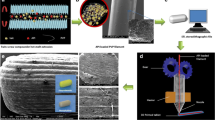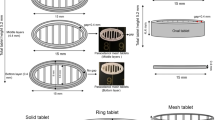Abstract
Purpose
Individualizing gastric-resistant tablets is associated with major challenges for clinical staff in hospitals and healthcare centres. This work aims to fabricate gastric-resistant 3D printed tablets using dual FDM 3D printing.
Methods
The gastric-resistant tablets were engineered by employing a range of shell-core designs using polyvinylpyrrolidone (PVP) and methacrylic acid co-polymer for core and shell structures respectively. Filaments for both core and shell were compounded using a twin-screw hot-melt extruder (HME). CAD software was utilized to design a capsule-shaped core with a complementary shell of increasing thicknesses (0.17, 0.35, 0.52, 0.70 or 0.87 mm). The physical form of the drug and its integrity following an FDM 3D printing were assessed using x-ray powder diffractometry (XRPD), thermal analysis and HPLC.
Results
A shell thickness ≥0.52 mm was deemed necessary in order to achieve sufficient core protection in the acid medium. The technology proved viable for incorporating different drug candidates; theophylline, budesonide and diclofenac sodium. XRPD indicated the presence of theophylline crystals whilst budesonide and diclofenac sodium remained amorphous in the PVP matrix of the filaments and 3D printed tablets. Fabricated tablets demonstrated gastric resistant properties and a pH responsive drug release pattern in both phosphate and bicarbonate buffers.
Conclusions
Despite its relatively limited resolution, FDM 3D printing proved to be a suitable platform for a single-process fabrication of delayed release tablets. This work reveals the potential of dual FDM 3D printing as a unique platform for personalising delayed release tablets to suit an individual patient’s needs.







Similar content being viewed by others
Abbreviations
- API:
-
Active pharmaceutical ingredient
- CAD:
-
Computer aided design
- DSC:
-
Differential scanning calorimetry
- FDM:
-
Fused Deposition Modelling
- HME:
-
Hot melt extrusion
- HPLC:
-
High performance liquid chromatography
- MTDSC:
-
Modulated temperature differential scanning calorimetry
- PEG:
-
Polyethylene glycol
- PVP:
-
Polyvinylpyrrolidone
- SEM:
-
Scanning electron microscopy
- TBP:
-
Tribasic sodium phosphate
- TEC:
-
Triethyl citrate
- Tg:
-
Glass transition temperature
- TGA:
-
Thermal gravimetric analysis
- Tm:
-
Melting point
- XRPD:
-
X-ray powder diffractometry
References
Raijada D, Genina N, Fors D, Wisaeus E, Peltonen J, Rantanen J, et al. A step toward development of printable dosage forms for poorly soluble drugs. J Pharm Sci. 2013;102(10):3694–704.
Habib WA, Alanizi AS, Abdelhamid MM, Alanizi FK. Accuracy of tablet splitting: comparison study between hand splitting and tablet cutter. Saudi Pharm J. 2014;22(5):454–9.
Peek BT, Al-Achi A, Coombs SJ. Accuracy of tablet splitting by elderly patients. JAMA. 2002;288(4):451–2.
Noviasky J, Lo V, Luft DD, Saseen J. Clinical inquiries. Which medications can be split without compromising efficacy and safety? J Fam Pract. 2006;55(8):707–8.
Skowyra J, Pietrzak K, Alhnan MA. Fabrication of extended-release patient-tailored prednisolone tablets via fused deposition modelling (FDM) 3D printing. Eur J Pharmaceut Sci. 2015;68:11–7.
Alhnan MA, Okwuosa TC, Sadia M, Wan KW, Ahmed W, Arafat B. Emergence of 3D printed dosage forms: opportunities and challenges. Pharm Res. 2016;33(8):1817–32.
Nollenberger K, Albers J. Poly(meth)acrylate-based coatings. Int J Pharm. 2013;457(2):461–9.
Sakae O, Hiroyasu K. Application of HPMC and HPMCAS to aqueous film coating of pharmaceutical dosage forms. In: McGinity JW, Felton LA, editors. Aqueous film coating of pharmaceutical dosage forms. Boca Raton: CRC Press; 2008.
Revision USPCCo. U.S. pharmacopeia & national formulary: United States Pharmacopeial Convention, Inc.; 2007.
Katstra WE, Palazzolo RD, Rowe CW, Giritlioglu B, Teung P, Cima MJ. Oral dosage forms fabricated by Three Dimensional Printing™. J Control Release. 2000;66(1):1–9.
Rowe CW, Katstra WE, Palazzolo RD, Giritlioglu B, Teung P, Cima MJ. Multimechanism oral dosage forms fabricated by three dimensional printing (TM). J Control Release. 2000;66(1):11–7.
Yu DG, Yang XL, Huang WD, Liu J, Wang YG, Xu H. Tablets with material gradients fabricated by three-dimensional printing. J Pharm Sci. 2007;96(9):2446–56.
Rowe CW, Wang CC, Monkhouse DC. TheriForm technology. In: Rathbone MJ, Hadgraft J, Roberts MS, editors. Modified-release drug delivery technology. 2nd ed. New York: Marcel Dekker Inc; 2003. p. 77–8.
Goyanes A, Buanz AB, Hatton GB, Gaisford S, Basit AW. 3D printing of modified-release aminosalicylate (4-ASA and 5-ASA) tablets. Eur J Pharmaceut Biopharmaceut: Off J Arbeitsgemeinschaft fur Pharmazeutische Verfahrenstechnik eV. 2014.
Goyanes A, Buanz ABM, Basit AW, Gaisford S. Fused-filament 3D printing (3DP) for fabrication of tablets. Int J Pharm. 2014;476(1–2):88–92.
Sandler N, Salmela I, Fallarero A, Rosling A, Khajeheian M, Kolakovic R, et al. Towards fabrication of 3D printed medical devices to prevent biofilm formation. Int J Pharm. 2014;459(1–2):62–4.
Pietrzak K, Isreb A, Alhnan MA. A flexible-dose dispenser for immediate and extended release 3D printed tablets. Eur J Pharmaceut Biopharmaceut: Off J Arbeitsgemeinschaft fur Pharmazeutische Verfahrenstechnik eV. 2015.
Okwuosa TC, Stefaniak D, Arafat B, Isreb A, Wan KW, Alhnan MA. A lower temperature FDM 3D printing for the manufacture of patient-specific immediate release tablets. Pharm Res. 2016.
Sadia M, Sosnicka A, Arafat B, Isreb A, Ahmed W, Kelarakis A, Alhnan MA. Adaptation of pharmaceutical excipients to FDM 3D printing for the fabrication of patient-tailored immediate release tablets. Int J Pharmaceut. 2016.
Goyanes A, Chang H, Sedough D, Hatton GB, Wang J, Buanz A, et al. Fabrication of controlled-release budesonide tablets via desktop (FDM) 3D printing. Int J Pharm. 2015;496(2):414–20.
Melocchi A, Parietti F, Maroni A, Foppoli A, Gazzaniga A, Zema L. Hot-melt extruded filaments based on pharmaceutical grade polymers for 3D printing by fused deposition modeling. Int J Pharm. 2016;509(1–2):255–63.
Hergel J, Lefebvre S. Clean color: improving multi-filament 3D prints. Comput Graphics Forum. 2014;33(2):469–78.
Reiner T, Carr N. Radom, #237, M r, #283, ch, Ond, #345, ej, #352, t’ava, Dachsbacher C, Miller G. Dual-color mixing for fused deposition modeling printers. Comput Graphics Forum. 2014;33(2):479–86.
Dudek P. FDM 3D printing technology in manufacturing composite elements. In.Archives of Metallurgy and Materials; 2013. p. 1415.
Goyanes A, Wang J, Buanz A, Martinez-Pacheco R, Telford R, Gaisford S, et al. 3D printing of medicines: engineering novel oral devices with unique design and drug release characteristics. Mol Pharm. 2015;12(11):4077–84.
Yu DG, Williams GR, Wang X, Liu XK, Li HL, Bligh SWA. Dual drug release nanocomposites prepared using a combination of electrospraying and electrospinning. RSC Adv. 2013;3(14):4652–8.
Yang C, Yu DG, Pan D, Liu XK, Wang X, Bligh SWA, et al. Electrospun pH-sensitive core shell polymer nanocomposites fabricated using a tri-axial process. Acta Biomater. 2016;35:77–86.
Fadda HM, Basit AW. Dissolution of pH responsive formulations in media resembling intestinal fluids: bicarbonate versus phosphate buffers. J Drug Deliv Sci Technol. 2005;15(4):273–9.
Alhnan MA, Cosi D, Murdan S, Basit AW. Inhibiting the gastric burst release of drugs from enteric microparticles: the influence of drug molecular mass and solubility. J Pharm Sci. 2010;99(11):4576–83.
Hao S, Wang B, Wang Y, Zhu L, Wang B, Guo T. Preparation of Eudragit L 100–55 enteric nanoparticles by a novel emulsion diffusion method. Colloids Surf B: Biointerfaces. 2013;108:127–33.
Thoma K, Bechtold K. Influence of aqueous coatings on the stability of enteric coated pellets and tablets. Eur J Pharm Biopharm. 1999;47(1):39–50.
Liu F, Lizio R, Meier C, Petereit HU, Blakey P, Basit AW. A novel concept in enteric coating: a double-coating system providing rapid drug release in the proximal small intestine. J Control Release. 2009;133(2):119–24.
Tudja P, Khan MZ, Mestrovic E, Horvat M, Golja P. Thermal behaviour of diclofenac sodium: decomposition and melting characteristics. Chem Pharm Bull (Tokyo). 2001;49(10):1245–50.
Verdonck E, Schaap K, Thomas LC. A discussion of the principles and applications of Modulated Temperature DSC (MTDSC). Int J Pharm. 1999;192(1):3–20.
Nair R, Nyamweya N, Gönen S, Martínez-Miranda LJ, Hoag SW. Influence of various drugs on the glass transition temperature of poly(vinylpyrrolidone): a thermodynamic and spectroscopic investigation. Int J Pharm. 2001;225(1–2):83–96.
Kim JE, Cho HJ, Kim DD. Budesonide/cyclodextrin complex-loaded lyophilized microparticles for intranasal application. Drug Dev Ind Pharm. 2014;40(6):743–8.
Toropainen T, Velaga S, Heikkila T, Matilainen L, Jarho P, Carlfors J, et al. Preparation of budesonide/gamma-cyclodextrin complexes in supercritical fluids with a novel SEDS method. J Pharm Sci. 2006;95(10):2235–45.
Korkiatithaweechai S, Umsarika P, Praphairaksit N, Muangsin N. Controlled release of diclofenac from matrix polymer of chitosan and oxidized konjac glucomannan. Mar Drugs. 2011;9(9):1649–63.
Liu F, Merchant HA, Kulkarni RP, Alkademi M, Basit AW. Evolution of a physiological pH 6.8 bicarbonate buffer system: application to the dissolution testing of enteric coated products. Eur J Pharmaceut Biopharmaceut: Off J Arbeitsgemeinschaft fur Pharmazeutische Verfahrenstechnik eV. 2011;78(1):151–7.
Ming-Thau S, Huei-Lan C, Ching-Cheng K, Cheng-Hsiung L, Sokoloski TD. Dissolution of diclofenac sodium from matrix tablets. Int J Pharm. 1992;85(1):57–63.
Bhatt H, Naik B, Dharamsi A. Solubility enhancement of budesonide and statistical optimization of coating variables for targeted drug delivery. J Pharmaceut. 2014;2014:13.
ACKNOWLEDGMENTS AND DISCLOSURES
The authors would like to thank UCLAN Innovation Team for their support and Mrs Rim Arafat for her help with graphics design.
Author information
Authors and Affiliations
Corresponding author
Electronic supplementary material
Below is the link to the electronic supplementary material.
ESM 1
(PDF 612 kb)
Rights and permissions
About this article
Cite this article
Okwuosa, T.C., Pereira, B.C., Arafat, B. et al. Fabricating a Shell-Core Delayed Release Tablet Using Dual FDM 3D Printing for Patient-Centred Therapy. Pharm Res 34, 427–437 (2017). https://doi.org/10.1007/s11095-016-2073-3
Received:
Accepted:
Published:
Issue Date:
DOI: https://doi.org/10.1007/s11095-016-2073-3




